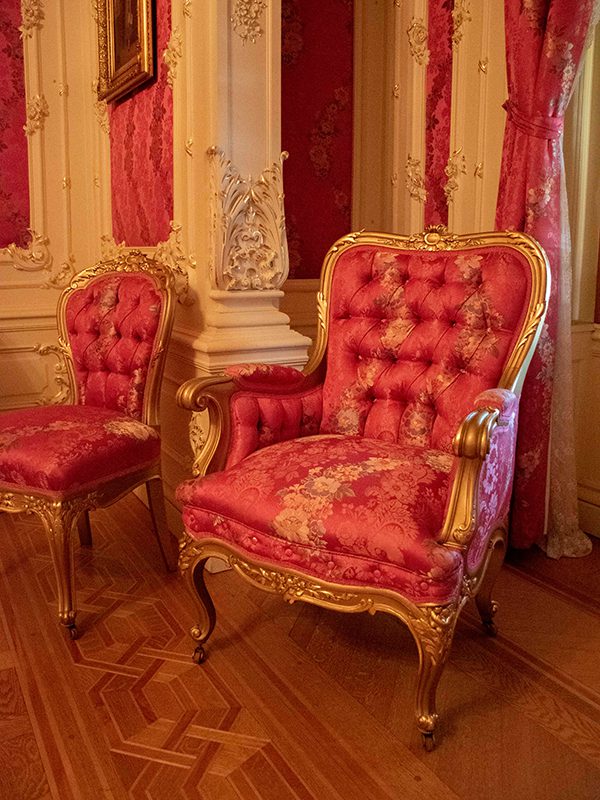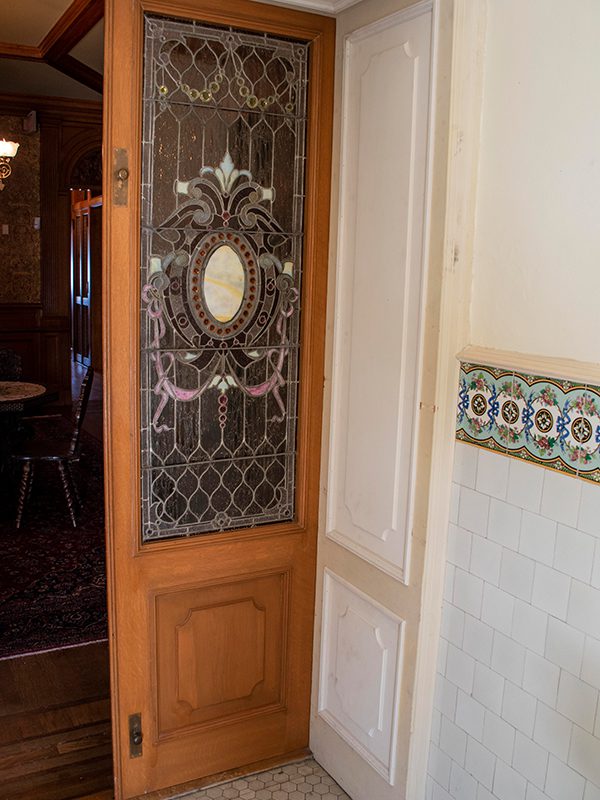Historic pictures of the Pabst Mansion helped guide the renovation of the rooms
To Captain Frederick Pabst, this was home. More than a century later, it’s an icon of Milwaukee’s past, a remarkable testament to local 19th century craftsmen and one of the few mansions of the Gilded Age remaining along Wisconsin Avenue.
Completed in 1892 (it took two years to build) at a cost of $254,000, the Mansion served as the Pabst family home for only 15 years. Yet its fate would be quite different than that of the neighboring mansions along this east-west corridor just west of downtown Milwaukee. While other historic buildings crumbled one by one, this legacy to the city’s brewing industry somehow survived.
Today, the challenge is to ensure preservation of the building so future generations can experience this frozen-in-time showcase of history. This is the task of Pamela Williams-Lime, President of the Pabst Mansion. Her vision is to use the mansion for education, tourism and study – to tell a story of Milwaukee’s past by showcasing the ornate rooms, furnishings and artwork inside this 127-year-old building.
“We see a future for our past,” Pamela said. “We imagine this being available for a long, long time to students, art scholars, tourists and anyone interested in history.”
Completed in 1892 (it took two years to build) at a cost of $254,000, the Mansion served as the Pabst family home for only 15 years. Yet its fate would be quite different than that of the neighboring mansions along this east-west corridor just west of downtown Milwaukee. While other historic buildings crumbled one by one, this legacy to the city’s brewing industry somehow survived.
Today, the challenge is to ensure preservation of the building so future generations can experience this frozen-in-time showcase of history. This is the task of Pamela Williams-Lime, President of the Pabst Mansion. Her vision is to use the mansion for education, tourism and study – to tell a story of Milwaukee’s past by showcasing the ornate rooms, furnishings and artwork inside this 127-year-old building.
“We see a future for our past,” Pamela said. “We imagine this being available for a long, long time to students, art scholars, tourists and anyone interested in history.”
The Pabst owes its survival in part to the Archdiocese of Milwaukee, which purchased the Mansion in 1908 as a residence for the archbishop and others in the church. In the mid-1970s, a group then known as Wisconsin Heritage, Inc. (now known as Pabst Mansion, Inc.) stepped up to save the building from potential demolition.
The building was placed on the National Historic Register and, in 1978, the doors were opened to the public. Since then, the organization poured millions of dollars into renovating the 20,000-SF building.
The building was placed on the National Historic Register and, in 1978, the doors were opened to the public. Since then, the organization poured millions of dollars into renovating the 20,000-SF building.
Much of the building now appears very close to how it looked at the turn of the 20th century. Today more than 40,000 people visit each year to experience a sampling of Milwaukee’s past. The tour through the three-story house is impressive.
Ornate furniture sits on beautifully kept oak floors, century-old artwork hangs above fireplace mantels and chandeliers hang above richly colored area rugs. Even the door knobs speak to the beauty that lies in the details of this Flemish Renaissance Revival style mansion.
“It truly is a gem,” Pamela said. “The question is how do we make sure it’s here for the long haul?”
The answer may be in restoring and maintaining the structure and operating systems of the building: making sure the ceiling doesn’t leak, heat and humidity are maintained, and weather does not compromise the integrity of the walls and windows.
Ornate furniture sits on beautifully kept oak floors, century-old artwork hangs above fireplace mantels and chandeliers hang above richly colored area rugs. Even the door knobs speak to the beauty that lies in the details of this Flemish Renaissance Revival style mansion.
“It truly is a gem,” Pamela said. “The question is how do we make sure it’s here for the long haul?”
The answer may be in restoring and maintaining the structure and operating systems of the building: making sure the ceiling doesn’t leak, heat and humidity are maintained, and weather does not compromise the integrity of the walls and windows.
This winter, the Pabst Mansion hired Strang to perform an assessment of the building envelope, structure and systems. Strang will make a recommendation in line with standards for Historic Restoration.
The goal is to make the building weather-tight, and make sure all systems are operating efficiently. At the same time, the work must be compatible and respectful of the original design and the original materials.
“There’s a delicate balance between restoring the rooms that people want to see and keeping up with the exterior work and building systems,” said Strang architect Kevin Donahue. “It’s a complicated dance.”
At that point, it will be up to the leaders of the Pabst to decide the best direction for creating a viable future for this icon of Milwaukee’s past.
“Our current goal is to make sure the structure’s been maintained,” Pamela said. “Then we can look forward to further expanding the guest experience and providing historians and students an opportunity to fully utilize the Mansion as a historic resource for generations to come.”
Because looking forward may just be the best way to preserve the past.
The goal is to make the building weather-tight, and make sure all systems are operating efficiently. At the same time, the work must be compatible and respectful of the original design and the original materials.
“There’s a delicate balance between restoring the rooms that people want to see and keeping up with the exterior work and building systems,” said Strang architect Kevin Donahue. “It’s a complicated dance.”
At that point, it will be up to the leaders of the Pabst to decide the best direction for creating a viable future for this icon of Milwaukee’s past.
“Our current goal is to make sure the structure’s been maintained,” Pamela said. “Then we can look forward to further expanding the guest experience and providing historians and students an opportunity to fully utilize the Mansion as a historic resource for generations to come.”
Because looking forward may just be the best way to preserve the past.














